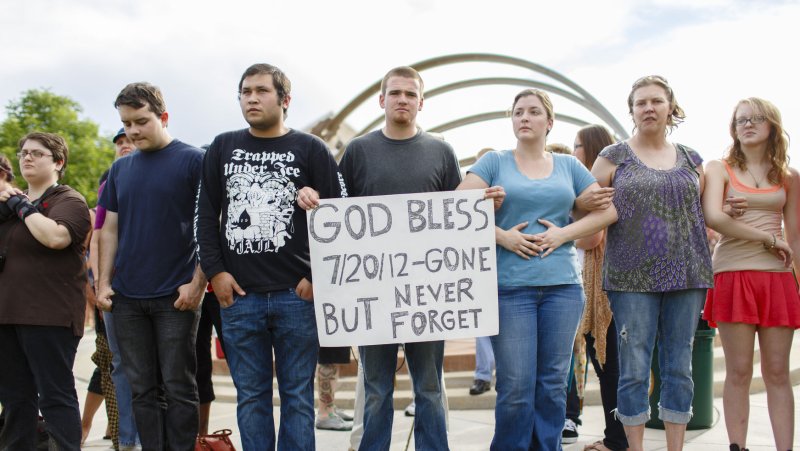Mourners gather for a prayer vigil at the Aurora Municipal Center on July 22, 2012 to honor the victims of last Friday's movie theater mass shooting at the Century 16 Movie theater complex in Aurora, Colorado. Suspect James Holmes, 24, allegedly went on a shooting spree, killing 12 people and injuring 58 during an early morning premier screening of 'The Dark Knight Rises.' UPI/Trevor Brown, Jr. |
License Photo
AURORA, Colo., July 25 (UPI) -- The Colorado movie theater gunman must have had target practice, police said, and other officials said some victims were unable to get immediate medical help.
The law enforcement officials told the Los Angeles Times they based their target-practice assessment on the gunman's "unusually high" hit rate in the shooting spree that killed 12 people and wounded 58 others in Aurora, Colo.
The officials said authorities were searching the apartment of suspect James Holmes for evidence of a gun-range receipt, a brochure, related information he got online or phone calls he may have placed to a range, the Times said.
Such information would provide additional evidence of premeditation and suggest the suspect deliberately planned the attack, the officials told the newspaper.
The evidence would also weaken a defense strategy that Holmes was insane, the officials said.
Even if he didn't go to a shooting range, the gunman could have gone out to the prairie east of Aurora and practiced alone, they said.
The scope of the massacre was unprecedented for Aurora, 10 miles east of Denver, and emergency medical workers treated every victim they came across in a parking lot outside the multiplex movie theater, fire officials said.
But they were unable to immediately get into the theater because the lot was packed with cars from patrons and police -- and they were treating victims in the parking lot.
"They were overwhelmed with patients," Aurora Fire Capt. Al Robnett told The Denver Post of the first responders who arrived 4 minutes 59 seconds after they were dispatched.
"Patients were running toward them. They were covered with blood. We cannot move past a patient to get to another patient," Robnett said.
What resulted was a medical response that initially helped the less seriously injured and then treated critically injured patients in the theater who couldn't be moved, the newspaper said.
When medical help finally did reach them, ambulances weren't available and police cars -- which were not equipped or staffed for lifesaving -- took victims to hospitals, dispatch recordings from that night indicated.
"I've got a child victim," a recording indicated an officer called. "I need rescue at the back door (of) Theater 9. Now."
But while the request was relayed right away, ambulances and trained medical responders stayed in the parking lot treating others.
By the time responders said they'd arrived at the back of the theater, 15 minutes, 49 seconds had elapsed since the call for help from Theater 9, and police had already moved nine or 10 patients into the parking lot.
The child patient apparently remained inside, the Post said.
She is believed to have been Veronica Moser-Sullivan, 6, who did not survive.
Fire department rescuers were thwarted by a lack of ambulances for transport, the recordings indicate.
"FYI right now we're loading patients into back of PD cars to get them transported," the first fire department responder to reach the theater said. "Any ambos we could get would be nice."
By then, 24 minutes had elapsed since the shooting.
None of the 25 ambulances that responded from several area hospitals were available or able to get where they were immediately needed, the Post said.
Gov. John Hickenlooper praised police for doing whatever it took to get medical aid to the wounded.
"I couldn't believe how many people got to the hospital by police cars and not by ambulance," Hickenlooper told the Post.
"Several people [he had spoken with from other jurisdictions] said: 'You know, where I am, the police won't touch injured people for fear they will hurt their back or whatever. These police looked at us, blood everywhere, and said, There are not ambulances here, we have to start taking people.'"















